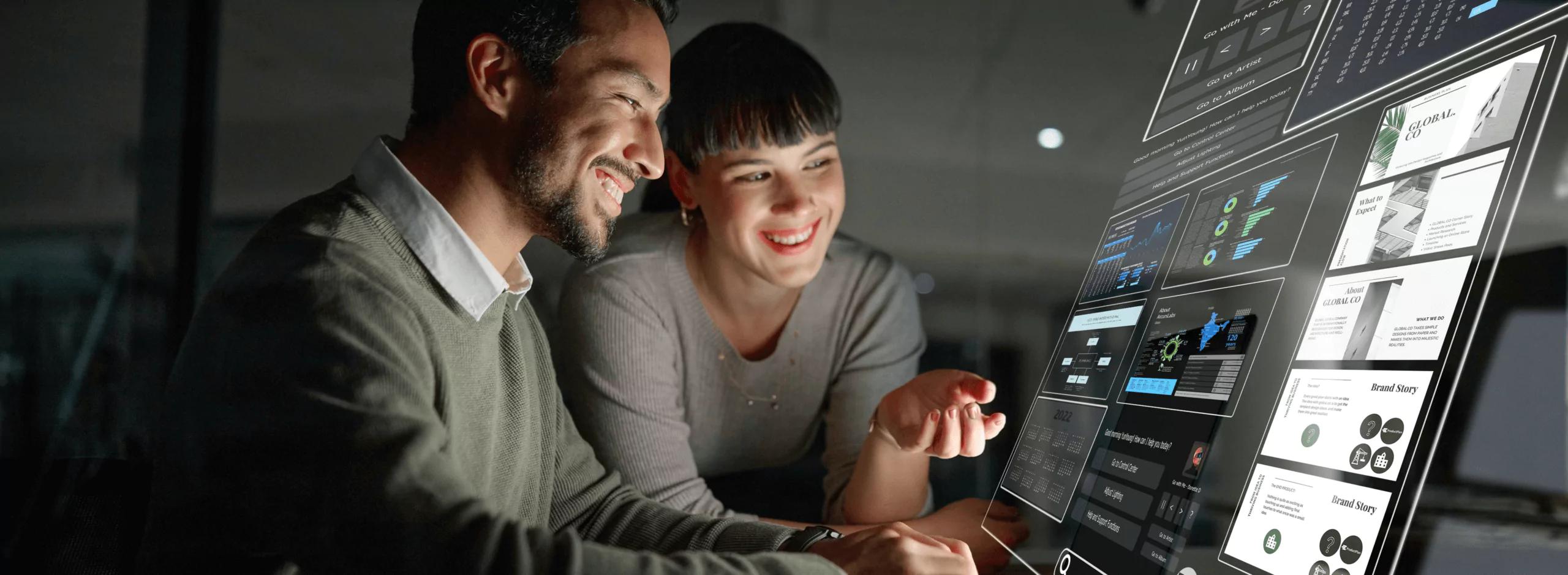

Rohan Sridhar
Posted On: January 27, 2025
Share
The world of UX design is evolving at an unprecedented pace, and artificial intelligence (AI) is playing an increasingly central role. From personalizing user interfaces to streamlining design processes, AI is transforming the way we approach UX, presenting both exciting opportunities and significant challenges. By 2025, AI will have permeated every aspect of UX design, from user research to prototyping and even user testing. Let’s explore where we currently stand, the challenges and ethical considerations, and where we might be headed with AI’s integration into UX.

Where Are We Currently with AI in UX?
AI has so far taken compelling steps into UX design primarily through assisting designers in repetitive tasks, giving real-time insights, and enhancing personalization. Presently, designers rely on AI-powered tools to automate the workflow parts such as making mockups, conducting user analysis, and designing personalized user experiences. For example, machine learning algorithms analyze user behavior, allowing designers to make data-driven decisions about design elements, layout structures, and interactive features that best meet users' needs.
Moreover, AI-powered analytics tools can process vast amounts of data to identify patterns, which designers can leverage to make informed decisions faster than ever before. While AI currently supports and enhances the role of UX designers, it is still far from taking over the creative, strategic, and empathetic aspects of UX design that only human designers can provide.
Challenges Faced with AI in UX Design
Despite AI's potential in UX design, several challenges remain:
1. Accuracy of User Insights: AI depends on data quality. If the data feeding into AI models is biased or limited, the insights it generates may misrepresent user needs, resulting in poor design decisions.
2. Complexity and Learning Curve: Many AI-powered tools come with a steep learning curve. Designers need to invest time in learning these new tools, which can disrupt established workflows.
3. Privacy Concerns: AI often relies on user data to function effectively, which raises privacy concerns. Ensuring data protection and complying with privacy regulations is a significant hurdle for AI in UX.
4. Bias in Algorithms: AI models may unintentionally incorporate biases from the data they are trained on, which can lead to biased design outcomes. Tackling these biases is a pressing concern for industry.
5. Cost and Accessibility: Advanced AI tools can be expensive, which can put them out of reach for smaller design teams or freelance designers. As AI tools become more widely used, balancing cost and accessibility will be crucial.

Will AI Replace UX Designers?
One of the most debated topics is the question of whether AI can replace UX designers. For all its capabilities in data-driven and repetitive tasks, AI cannot empathize, be sensitive to cultural nuances, or create experiences that feel emotional for users. Meaningful user experience design requires a combination of creativity, empathy, and human instinct, which AI, in its present form, cannot provide.
AI will likely serve as a powerful tool to make the work of UX designers more efficient and streamlined, rather than replace them. By automating routine tasks, AI frees designers to concentrate on complex problem-solving, innovation, and refinement of user interactions. Rather than replacing UX designers, AI is expected to be a supportive collaborator, helping designers achieve higher levels of efficiency and creativity.
Is AI in UX Design Ethical?
The ethical implications of AI in UX design are complex and demand careful consideration. Here are some critical questions and challenges:
1. Privacy: How much user data should AI models access to personalize UX, and how do we protect that data from misuse?
2. Transparency: Users may not always know when they are interacting with AI-powered elements in an interface, which raises questions about transparency.
3. Bias: As discussed, AI models can inadvertently reflect societal biases, potentially leading to discriminatory design outcomes.
4. Autonomy: How much control should AI have in making design decisions, and at what point does it begin to undermine the designer’s role?
These ethical considerations highlight the need for human oversight in AI-driven design processes. As AI becomes more prevalent in UX design, the industry will need to establish ethical guidelines to ensure responsible use.

Future Trends in UX with AI
The future of AI in UX design holds exciting possibilities. Here are some trends expected to shape UX by 2025:
1. Hyper-Personalization: AI algorithms will enable hyper-personalized user experiences, adapting interfaces in real-time based on individual user preferences, behavior, and context.
2. Predictive Design: Using predictive analytics, AI could anticipate user needs and adjust design elements accordingly. For instance, AI could identify potential user issues before they occur, allowing designers to proactively improve user flows.
3. Voice and Gesture Recognition: As voice and gesture recognition technology advances, AI will facilitate hands-free, more natural interactions, transforming traditional interfaces into more intuitive experiences.
4. Design Automation and Prototyping: AI-powered tools will further streamline design processes by automatically generating prototypes and iterating on designs based on user feedback and testing data.
5. Augmented Reality (AR) and Virtual Reality (VR) Integration: With AI, UX design will likely extend beyond 2D screens, creating immersive experiences in AR and VR environments, where AI can play a vital role in adapting content to user interactions.
AI Plugins and Tools That Designers Already Use
Many AI-powered tools and plugins are already transforming how designers work. Here are some popular ones:
1. Adobe Sensei: Integrated into Adobe Creative Cloud, Sensei leverages AI to help designers work more efficiently, offering features like auto-tagging, content-aware fill, and style transfer.
2. Figma with AI Plugins: Figma has integrated several AI-powered plugins, such as Autoflow for quick prototyping and Remove.bg for image background removal, which enhance designers' productivity.
3. Sketch’s Design System Assistant: This plugin uses AI to enforce design consistency, identifying deviations from design guidelines automatically.
4. Uizard: Uizard is an AI-powered design tool that helps turn sketches into wireframes and wireframes into prototypes, making rapid prototyping accessible and efficient.
5. Runway ML: Runway ML is an advanced AI tool for media and design professionals, offering various applications like generating images, video editing, and creating special effects using machine learning.
These tools enhance productivity and creativity by allowing designers to focus on the bigger picture rather than getting bogged down by repetitive tasks.

Different AI Forms and Their Contributions to UX Design
AI encompasses several types of technology, each contributing uniquely to UX design:
1. Machine Learning (ML): ML algorithms learn from data, making them ideal for personalizing experiences based on user behavior. By analyzing patterns, ML can suggest design adjustments to meet user preferences more effectively.
2. Natural Language Processing (NLP): NLP powers chatbots and virtual assistants, enabling designers to incorporate conversational interfaces that improve user engagement and streamline support.
3. Computer Vision: This technology allows AI to process and analyze visual data, aiding in tasks like image recognition and content-aware editing, which are useful in various UX design applications.
4. Generative Design: Generative design uses AI to explore thousands of design solutions based on defined constraints, offering designers an array of options to choose from and refine further.
5. Predictive Analytics: By predicting user behavior based on historical data, predictive analytics allows designers to make proactive design improvements, enhancing user satisfaction.
Each of these AI forms contributes to UX design in different ways, helping to create a more personalized, intuitive, and efficient user experience.

Conclusion
The landscape of UX design will, by 2025, fully integrate AI into the workflow as an essential tool for reshaping the industry through automation, personalization, and predictive analytics. While AI cannot take over human designers' creativity and empathy, it will undoubtedly act as a powerful ally in developing capacities to enhance design capabilities, streamline workflows, and create even more user-centric experiences. The future of UX design lies in a harmonious integration of human creativity with the power of artificial intelligence, promising an unprecedentedly innovative and individualized user experience.
At Happening, we do not just follow the trends of UX design; instead, we lead them. Being an AI-first UX design company, we work with cutting-edge AI tools and strategies in every project, guaranteeing experiences that are intuitive as well as uniquely tailored to the user. Our commitment to integrating AI's power with human-centered design allows us to develop solutions that are efficient, innovative, and deeply impactful.
If you're ready to explore how AI can enhance your design projects or want to discuss the future of AI in UX design, reach out to our team at hello@happening.design. Let’s shape the future of UX together!
Get the best advice from our top talented subject experts. Any time. Any matter.

